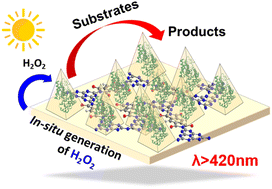Constructing a new platform for photo-peroxidase catalysis: ZIF-90 as a dual ‘modulator’ to overcome peroxide industrial application bottlenecks†
Abstract
Since peroxidases have potential applications as biocatalysts, it is important to improve their usefulness. Traditional “semiconductor photocatalyst + peroxidase” catalytic cascade systems are inspired by nature's photosynthesis and provide the basis for maintaining the optimal stability and reactivity of the peroxidase enzyme. However, inherent fragility, non-recyclability, and low catalytic efficiency still limit their industrial application. In this work, we present a new generation of photoperoxidase catalytic platform, g-C3N4/PDI-HRP@ZIF-90 (graphite carbon nitride; PDI: perylene diimide; and HRP: horseradish peroxidase), for efficient photo-peroxidase catalysis. This new composite catalyst was created by introducing a rationally designed metal–organic framework (ZIF-90) in situ as a dual “modulator” for the “semiconductor photocatalyst + peroxidase” catalytic cascade system, which is highly applicable to industrial applications. In situ introduced modulators of ZIF-90 not only significantly increase the electron transfer rate but also significantly improve enzyme stability, cyclability, and molecular transfer rates between photoenzyme catalytic systems through spatial confinement. The new catalytic system (semiconductor + MOF + peroxidase) is capable of responding to a cascade catalytic reaction with wavelengths > 420 nm and is resistant to a catalytic environment at pH = 3. This work outlines a versatile and effective strategy to use the properties of MOFs to improve two major drawbacks of the efficient industrial use of peroxidases (inefficiency and poor stability), paving the way for efficient green biomanufacturing industrialization using peroxidases.

- This article is part of the themed collection: FOCUS: Design and applications of metal-organic frameworks (MOFs)


 Please wait while we load your content...
Please wait while we load your content...